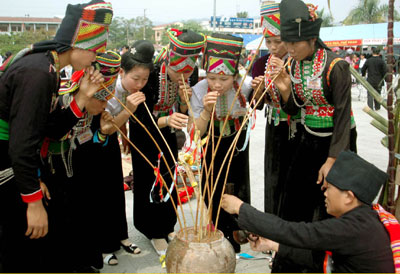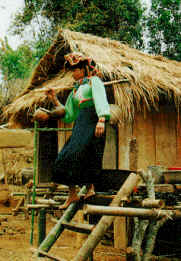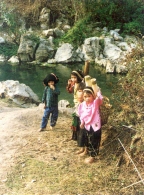The Khang mainly practice slash-and-burn cultivation with traditional techniques such as: to dig holes and put seeds into the holes. They grow plenty of sticky rice to serve as their staple food. In certain places, the Khang plough and harrow the fields, then distribute seeds. They also do farming. on a few of terraced fields. Animal husbandry is popular. Their basketry articles including chairs, baskets, flat baskets, suitcases, packs and wooden boats in swallow-tail shape-are much liked by the Thai people. The Khang often carry single-handle pack over their forehead.
The Khang grow cotton and exchange it for cloth and garments from the Thai. Khang women dye their teeth black and chew betel.
The Khang live in houses on stilts. The house comprises three compartments and two lean-tos with roof in shape of tortoise's carapace, two entrance doors open at both ends and two windows open at the two sides. Each house has two kitchens, one used to cook daily meals and the other used to warm and cook offering meals to worship the dead parents.
According to custom, marriage goes through three steps: marriage proposal, matri locate approval and wedding. The wedding is celebrated in two stages. The first stage is held for the groom's matrilocate; the second stage is held to accompany the bride to her husband's home to set her own nuclear family. The maternal uncle plays a special role in his nephews' and nieces' marriage.
It is customary that the dead person is carefully buried. On his or her grave, a funeral house is built and filled with objects used for the deceased such as: suitcase, rice basket, drink pipe, bowls and chopsticks. At the front of the grave, a 4-5 metre long pole is erected and on the top of the pole, a wood bird and a shirt belonged to the deceased's wife (or husband) is hung over.
In the Khang's concepts, each person has five souls. After death, a soul remains in the house, one goes to the fields, one settles at the foot of the tree which was cut to make the coffin, other lives in funeral house and the rest flies to the sky. After the parents died, a bamboo altar is set up in a corner of the house to worship their souls which are called the souls of the house. Once every year, all the villagers celebrate together the veneration of the spirits of the heaven and the earth.






